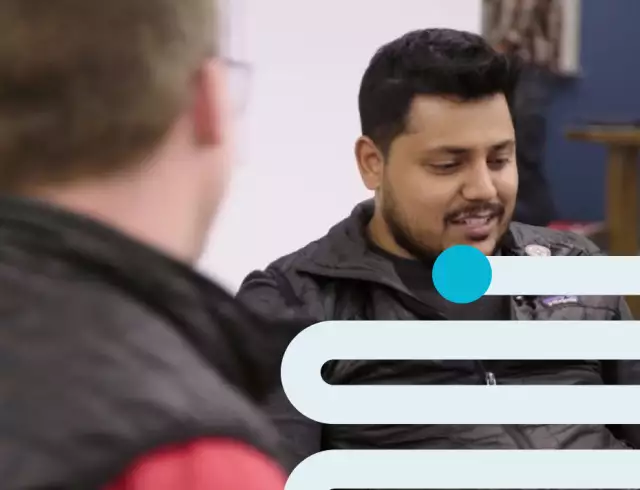
REVENUE LIFECYCLE MANAGEMENT (RLM) SOFTWARE
Unlock your revenue potential with Conga Revenue Lifecycle Management
Capture revenue more easily at every step—from negotiation to contract and renewal with our fully integrated Conga Advantage Platform
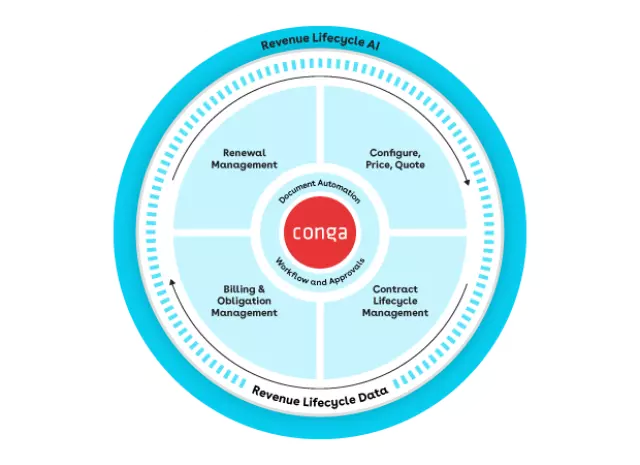
Over 10,000 businesses around the world rely on Conga
Why RLM matters
Revenue lifecycle management is the thread that ties siloed business processes together, including that of sales, legal, finance, IT, and HR. It allows you to optimize your revenue at every stage of the customer journey, from the time an opportunity is captured to contract renewals.
RLM prioritizes the top line, generating significantly more revenue and giving you a Revenue Advantage. After all, it’s not easy to track all the revenue flowing into your business. Multiple revenue types and channels further complicate matters.
Diverse revenue streams
Revenue from a variety of sources makes it challenging to manage them effectively:
|
Multiple sales channels
Customers want an omnichannel experience, including channels like:
|
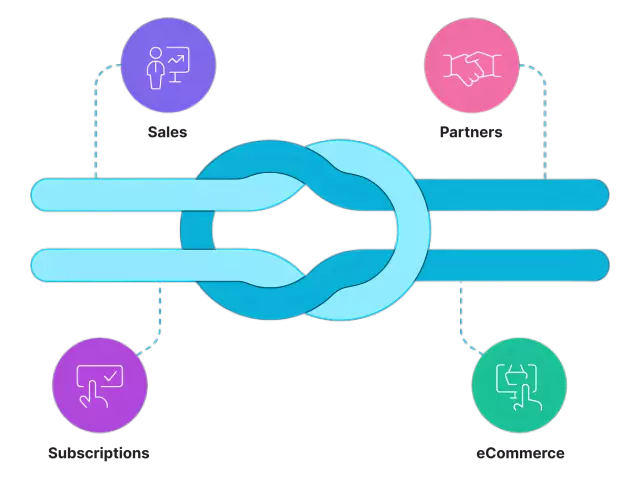
The need for a unified approach to revenue management
The only way to move ahead of your competitors is to capture your revenue faster and cheaper, and create a revenue engine to fuel your growth. Without an integrated approach to revenue lifecycle management, your business suffers from challenges like:
Siloed systems and lack of visibility
Manual processes
Difficulty in tracking revenue
Conga RLM: how everything flows together
Managing revenue doesn’t have to be a complex web of disconnected processes. With Conga's Revenue Lifecycle Management (RLM) software, every revenue function is part of a seamless flow—from initial proposal to contract fulfillment.
Each stage of the revenue lifecycle feeds into the next, creating a continuous, connected process that maximizes efficiency and reduces friction. By capturing every revenue opportunity under one platform, you achieve faster growth, greater profitability, and deeper customer relationships.
Automate, optimize, and scale quoting and sales processes
Manage configuration and pricing
- Optimize product selection: Use guided selling to streamline product choices.
- Ensure accurate pricing: Integrate sales with real-time pricing data.
- Handle complex configurations: Quickly quote even the most intricate product and service combinations.
Accelerate quoting and approvals
- Automate quote generation: Create detailed quotes at the click of a button.
- Expedite approvals: Integrated approval workflows mean faster decision-making and fewer bottlenecks.
- Boost sales efficiency: Automate pricing and quoting for the sales teams.
Maximize upsell and cross-sell
- Leverage intelligent suggestions: Offer upsell and cross-sell recommendations based on customer data and history.
- Increase revenue potential: Ensure your sales teams never miss an opportunity to enhance deals with relevant add-ons.
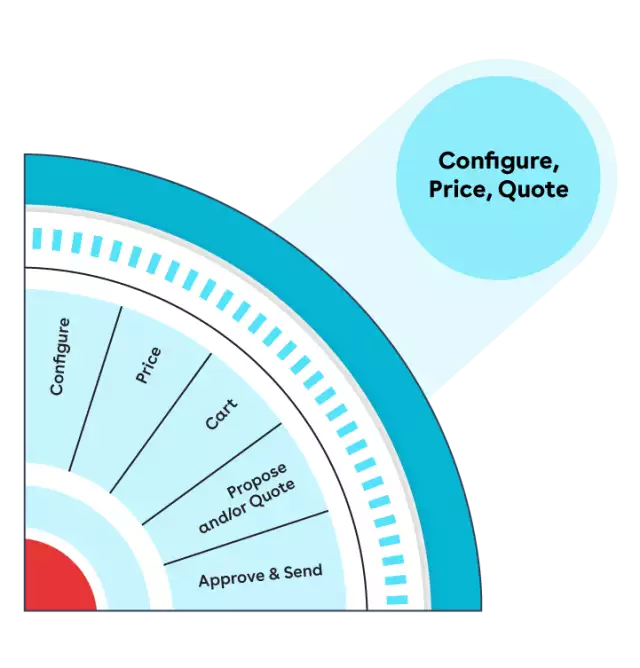
Streamline approvals and manage contract compliance
Speed up contract creation and negotiation
- Automate document generation: Use pre-approved templates to create contracts in minutes, not days.
- Negotiate confidently: Track changes, maintain version control, and accelerate negotiations with automated workflows.
- Ensure compliance: Built-in risk assessment tools flag risky clauses and suggest compliant alternatives.
Execute contracts seamlessly
- Secure eSignatures: Collect electronic signatures quickly and securely with Conga Sign.
- Track document progress: Keep all stakeholders informed at every stage of execution with automated status updates.
- Eliminate manual errors: Reduce the chance of human errors with standardized contract templates and automation.
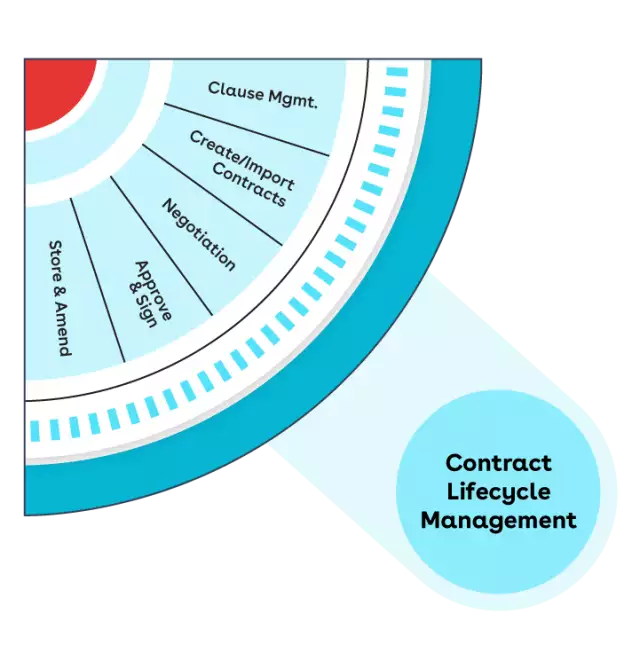
Centralize contract management and ensure precise fulfillment
Optimize order fulfillment
- Automate order processing: Integrate with ERP and fulfillment systems to streamline order management.
- Ensure order accuracy: Deliver correct product and service every time, with automated workflows.
- Manage product and service fulfillment: Seamlessly handle both physical and digital product fulfillment from a single platform.
Automate invoicing and billing
- Invoice and bill in a single click: Leverage the single source of data to create accurate invoices with up-to-date prices.
- Improve cash flow management: Automate reminders and notifications for outstanding invoices to accelerate payments.
- Connect with ERP systems: Integrate Conga with your enterprise resource planning software to fulfill the revenue recognition process.
Monitor contract performance
- Track obligations and commitments: Ensure contract fulfillment by all parties with centralized contract management.
- Automate renewals and billing: Set up automatic renewals and billing to ensure continuity without manual intervention.
- Gain insights from performance data: Use real-time data to monitor how well contracts are being fulfilled and adjust accordingly.
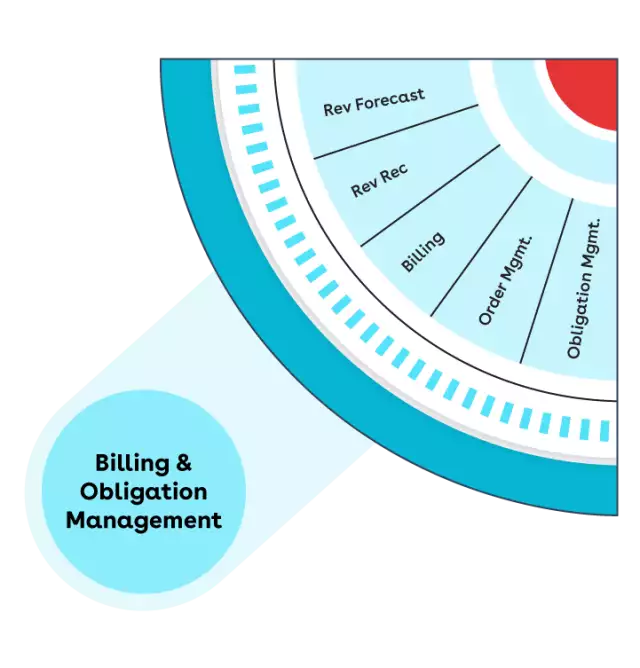
Capture renewals and growth opportunities
Maximize renewal opportunities
- Automate renewal processes: Set proactive alerts and workflows to help manage renewals without delays.
- Leverage customer data: Use data from previous transactions to tailor renewal offers.
- Simplify complex renewals: Easily manage renewals for large contracts or those with multiple line items.
Drive expansion with upsell and cross-sell
- Identify new opportunities: Reveal untapped upsell and cross-sell opportunities with AI-powered insights.
- Create tailored expansion offers: Customize offers to meet the evolving needs of existing customers.
- Grow revenue consistently: Build long-term customer relationships by continuously offering value through renewals and expansions.
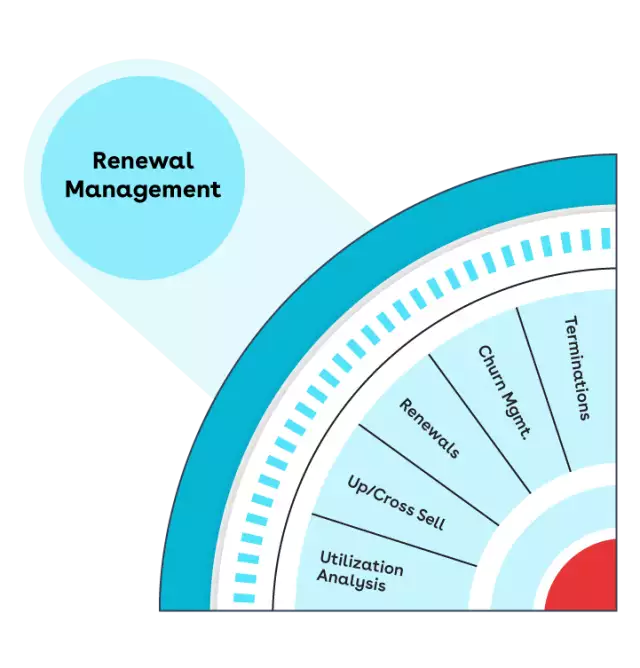
Why choose Conga RLM
With Conga Revenue Lifecycle Management, businesses harness the power of automation, AI, and data integration to manage every step of their revenue process—from quote to cash.
Revenue predictability
Ensure consistent revenue flow with a single source of truth for all revenue operations.
Revenue velocity
Accelerate deal closures and approvals with automated workflows and document management.
Revenue innovation
Unlock new revenue streams using AI-driven insights and predictive analytics.
Revenue lifetime value
Maximize lifetime value with efficient renewals and proactive customer expansion strategies.
Revenue quality
Enhance deal accuracy and compliance with automated, error-free processes.
Revenue efficiency
Increase operational efficiency by automating workflows and minimizing manual efforts.
Meet the Conga Advantage Platform—the premier revenue optimization software
The interactions with customers, the creation of contracts, the configuration of products, and the management of billing must come together in perfect harmony to produce a beautiful, cohesive outcome.
Conga's platform is built to be the ultimate solution for Revenue Lifecycle Management (RLM), seamlessly connecting every phase of the revenue process. It includes Revenue & Commerce, Document Automation, and CLM, which all work together to capture revenue.

Unified platform for every need
- All-in-one revenue solution: Integrate CPQ, CLM, document automation, billing, and more into one cohesive platform.
- Streamlined operations: Centralize all revenue processes to reduce complexity and ensure consistency.
- Adapt to your business: Configurable workflows and flexible tools allow Conga to scale and fit the unique needs of any organization.

End-to-end visibility and control
- Holistic insights: Gain full visibility into your revenue pipeline, from initial proposals to renewals.
- Track performance in real-time: Use data-driven insights to monitor and optimize every aspect of your revenue lifecycle.
- Reduce risk and ensure compliance: Automated workflows help mitigate risks by ensuring contracts and processes meet regulatory standards.

Future-ready innovation
- AI-powered intelligence: Leverage advanced analytics and machine learning to identify growth opportunities and predict potential risks.
- Composable architecture: Build a solution that fits into your existing ecosystem, integrating with third-party platforms and applications.
- Global reach: Conga supports businesses in every market, with localization and compliance tools designed for different regions and industries.
Ready to unlock the full potential of your revenue operations?
Don't miss out on the opportunity to maximize your revenue. Contact us today to see how you can do it with Conga.
Frequently asked questions
-
What is revenue lifecycle management?
Revenue Lifecycle Management (RLM) is a comprehensive approach that manages the entire process of generating and capturing revenue from customer relationships. Key components include:
- Proposal
- Quote
- Negotiation
- Execution
- Management
- Fulfillment
- Renewal
- Expansion
-
What are the benefits of RLM?
With RLM integrated into your operations, you benefit from:
- Streamlined processes: RLM automates quoting, contract creation, and approvals to speed up the revenue cycle and reduce manual effort.
- Reduced errors: It centralizes data and automates workflows to minimize mistakes in quotes, contracts, and billing.
- Enhanced collaboration among teams: RLM provides a unified platform for sales, finance, legal, and IT teams to access information and work together effectively.
- Maximized revenue: It optimizes every stage of the revenue lifecycle to capture more value through intelligent pricing, upselling, and timely renewals.
- Improved operational efficiency: RLM automates tasks and offers performance insights, leading to faster response times and better resource allocation.
-
What is a revenue lifecycle management platform?
A revenue lifecycle management platform is a centralized software solution that automates and connects all aspects of revenue management. Key features include:
- Integration: Combining document automation, configure, price, quote (CPQ), and contract lifecycle management (CLM).
- Workflow automation: Streamlining revenue-contributing processes to enhance efficiency.
- Data insights: Providing customer behavior data for better decision-making.
- Compliance: Ensuring that all revenue processes meet legal and regulatory standards.
-
How is RLM different than using individual revenue operations solutions?
RLM connects various revenue processes into one cohesive platform, while individual solutions often provide more limited insights or require additional effort to combine data from different sources.
Revenue lifecycle management platform
Individual revenue operations solutions
Unified platform
Standalone tools
End-to-end visibility
Limited integration
Automation and efficiency
Manual processes
Data-driven insights
Data silos
Improved collaboration
Fragmented view
-
How is Conga’s RLM different from Salesforce Revenue Cloud?
Salesforce Revenue Cloud is the suite of RLM solutions offered by Salesforce. While both Conga RLM and Salesforce revenue lifecycle management solutions integrate revenue streams, Conga has additional features that simplify every part of your lifecycle.
With our RLM solution, you can:
- Generate documents of any file type (invoices, contracts, proposals) with built-in document generation tool, Conga Composer
- Send documents anywhere for eSignatures directly from the platform
- Integrate the platform anywhere with open API
- Leverage advanced approval workflows
- Manage the entire revenue lifecycle, not just sales
While revenue lifecycle management by Salesforce is targeted toward sales teams, Conga creates seamless cross-functional team collaboration. With Conga, every department can work on the same platform, creating a single source of truth.








